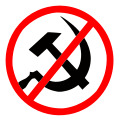This article may require copy editing for spelling / tone / cohesion.(September 2025) |
| Part of a series on |
| Anti-fascism |
|---|
 |
Variations of the red triangle and red wedge have been used for over a century to represent anti-fascism and other left-wing political ideologies. [2] In Western Europe the most well-known historical example is the inverted red triangle that represents opposition to Germany's Nazi Party and resistance to Nazi Germany's military occupation of Europe during World War Two. [3] This inverted red triangle symbol was reclaimed by anti-fascists in Europe after being used on prisoner uniforms in concentration camps in Nazi Germany and occupied Europe. A red triangle patch pointing upwards designated prisoners within the jurisdiction of the Wehrmacht, including prisoners of war,[ citation needed ] spies, and military deserters. [4] Whereas an inverted red triangle was worn by political prisoners, including resistance fighters. [3] [5] [6] The Nazis chose red because the first people to wear it were Communists. Besides Communists, liberals, anarchists, Social Democrats, Freemasons, and other opposition party members also wore a red triangle. [6] [7] After the war the red triangle symbol was reclaimed as a symbol of resistance against the German occupation of Europe during the war, similar to the way that the pink triangle used to mark gay prisoners became a symbol of LGBTQ pride. [3] The reclaimed red triangle symbol has been used as the logo for the Association of Persecutees of the Nazi Regime – Federation of Antifascists (VVN-BdA) in Germany, and numerous other post-war remembrances and memorial groups, it has also been worn as a lapel pin by left-wing politicians from Belgium, France, and Spain. Other left-wing, anti-fascist, and resistance groups have used red triangle or red wedge symbols that reference images and symbols from before WWII. [2] One of these is Beat the Whites with the Red Wedge , a 1919 propaganda poster by El Lissitzky. [2] An even earlier image recalled by some labour movements is an equilateral triangle representing eight-hours of work, eight-hours of leisure, and eight hours of sleep in the 24-hours of a day. In 2020, Donald Trump's presidential re-election campaign attracted controversy by using the symbol in social media adversisements attacking his own far-left opponents, whom he described as "Antifa". [8]
Contents
- Before Nazi Germany
- Eight-hour workday
- El Lissitzky's Red Wedge
- Opponents of the Nazi Party
- Background to Nazi persecution of left-wing opponents
- The red triangle badge in Nazi concentration camps
- After WWII
- Association of Persecutees of the Nazi Regime – Federation of Antifascists
- Use in East Germany (Deutsche Demokratische Republik)
- The red triangle on memorials
- Service medals
- Belgium
- Recent anti-fascist and left-wing usage
- Symbols at protests
- Political discourse
- Red triangle lapel pins in European politics
- Modern persecution of leftists and criticism of the far-right
- Logos of political and activist groups
- The red triangle and red wedge in arts and media
- Left-wing news and non-fiction
- Music
- Visual arts
- Fiction
- See also
- References
- Footnotes
- Citations
- External links






![Cover of Der Apikojres [he] No. 6 (Yiddish: d`r Apyqvyr`s
), by El Lissitzky in 1931 (a periodical published by the League of Militant Atheists). Der Apikoires 1931 No. 6.jpg](http://upload.wikimedia.org/wikipedia/commons/thumb/5/5e/Der_Apikoires_1931_%E2%84%96_6.jpg/330px-Der_Apikoires_1931_%E2%84%96_6.jpg)










































